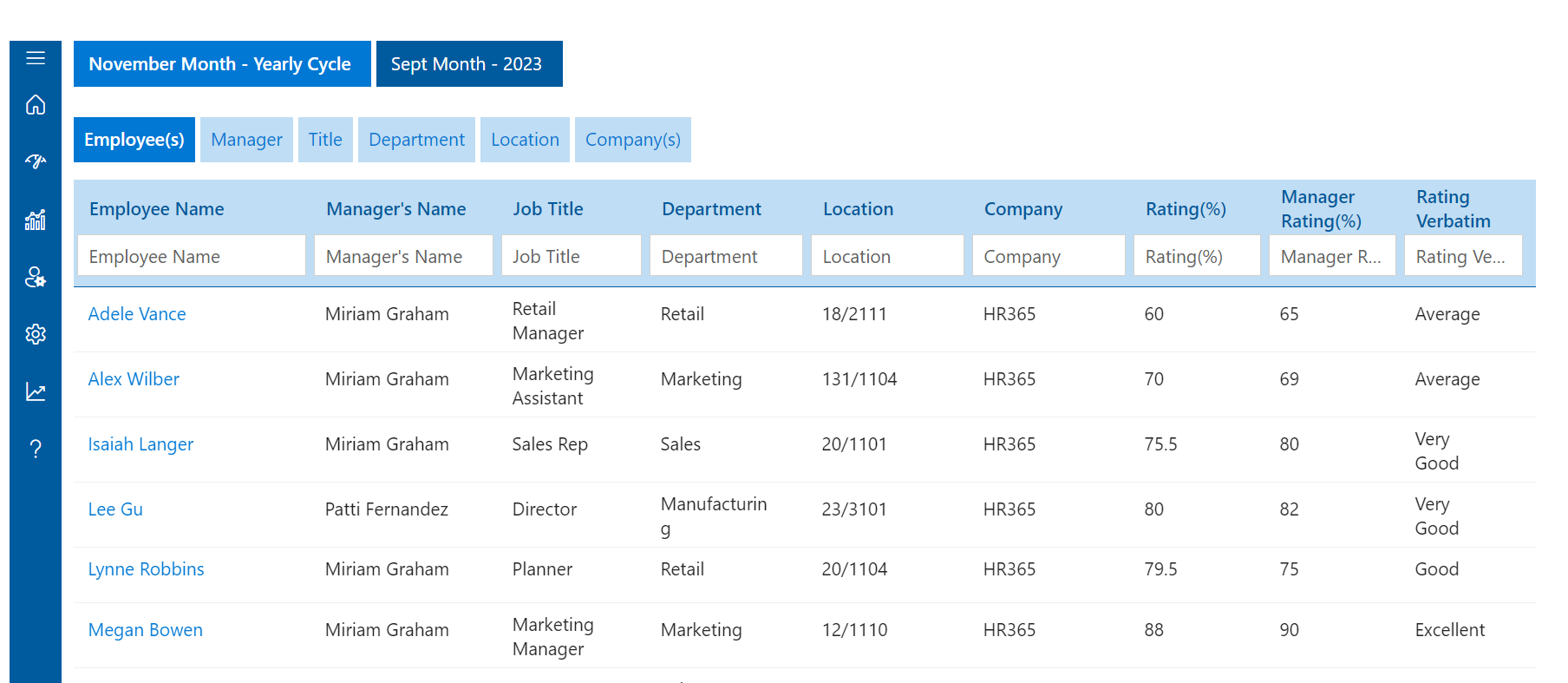Performance Review
A performance review is a structured evaluation process that assesses an individual’s job performance and accomplishments within a specific timeframe.
What is a Performance review?
A performance review, also known as a performance appraisal or evaluation, is a formal process undertaken by employers to assess and evaluate an employee’s job performance, productivity, and contribution to the organization. It typically occurs periodically, often annually, although some companies conduct reviews more frequently.
The primary purpose of a performance review is to provide feedback to employees regarding their strengths, areas for improvement, and overall effectiveness in meeting job expectations and objectives. Additionally, performance reviews serve as a basis for making decisions related to promotions, salary increases, bonuses, training needs, and potential areas for development or corrective action.
During a performance review, supervisors or managers typically assess various aspects of an employee’s work performance, including:
What is Employee Performance Management Software?
A performance review, also known as a performance appraisal or evaluation, is a formal process undertaken by employers to assess and evaluate an employee’s job performance, productivity, and contribution to the organization. It typically occurs periodically, often annually, although some companies conduct reviews more frequently.
The primary purpose of a performance review is to provide feedback to employees regarding their strengths, areas for improvement, and overall effectiveness in meeting job expectations and objectives. Additionally, performance reviews serve as a basis for making decisions related to promotions, salary increases, bonuses, training needs, and potential areas for development or corrective action.
During a performance review, supervisors or managers typically assess various aspects of an employee’s work performance, including:
- Goal Achievement: Reviewing the extent to which the employee has met or exceeded goals and objectives set during the previous review period.
- Skills and Competencies: Evaluating the employee’s skills, competencies, and abilities relevant to their job role.
- Work Quality: Assessing the quality of the employee’s work output, attention to detail, and adherence to established standards and procedures.
- Communication and Collaboration: Reviewing the employee’s effectiveness in communicating with colleagues, collaborating on projects, and contributing to team efforts.
- Initiative and Innovation: Recognizing instances where the employee has demonstrated initiative, creativity, or innovation in problem-solving or process improvement.
- Professionalism and Work Ethic: Evaluating the employee’s professionalism, reliability, work ethic, and adherence to organizational values and standards of conduct.
- Development Needs: Identifying areas where the employee may require additional training, coaching, or development to enhance their skills and capabilities.
Performance reviews often involve a formal meeting between the employee and their supervisor or manager, during which feedback is provided, performance ratings may be assigned, and goals or objectives for the upcoming review period are established. These discussions are intended to be constructive and supportive, fostering open communication and mutual understanding between the employee and their supervisor.
Purpose and Objectives
The purpose and objectives of a performance management review serve as the foundation for the entire evaluation process, guiding both employees and managers toward specific outcomes. Understanding these fundamental aspects is essential for ensuring that performance reviews effectively contribute to organizational success and individual growth.
- Clarifying Expectations: Performance reviews provide an opportunity to clarify job expectations, responsibilities, and performance standards. By aligning employee efforts with organizational goals, employees gain a clear understanding of what is expected of them, fostering a sense of direction and purpose.
- Evaluating Performance: One of the primary objectives of performance reviews is to assess employee performance against established goals and objectives. Through this evaluation, managers can identify areas of strength and areas needing improvement, enabling informed decision-making regarding rewards, promotions, and developmental opportunities.
- Providing Feedback: Microsoft Performance management software facilitate open communication between managers and employees by providing a structured framework for delivering constructive feedback. Positive feedback acknowledges achievements and reinforces desired behaviors, while constructive feedback addresses areas for improvement and outlines actionable steps for development.
- Promoting Development: Another key objective of performance management software is to support employee development and growth. By identifying strengths and areas for improvement, managers can create personalized development plans that enhance employee skills, knowledge, and competencies. These plans may include training opportunities, mentoring, or stretch assignments aimed at fostering continuous improvement.
- Recognizing Contributions: Performance reviews offer an opportunity to recognize and celebrate employee contributions and accomplishments. Acknowledging achievements not only boosts morale and motivation but also reinforces desired behaviors and encourages continued excellence.
- Facilitating Goal Setting: Performance reviews serve as a platform for setting new goals and objectives for the upcoming review period. By collaboratively establishing clear, achievable goals, managers and employees can align their efforts and focus on priorities that drive individual and organizational success.
- Supporting Decision-Making: Performance reviews provide valuable data and insights that inform decision-making processes related to compensation, promotions, and talent management. Objective performance evaluations help ensure fairness and transparency in decision-making, fostering trust and accountability within the organization.
The purpose and objectives of a performance review encompass a comprehensive approach to assessing, developing, and rewarding employee performance, ultimately contributing to organizational effectiveness and employee engagement.
Setting Performance Goals
Setting performance goals is a critical component of the performance review process, laying the foundation for employee development and organizational success. It involves establishing clear, specific, and achievable objectives that align with both individual responsibilities and broader organizational priorities.
- Alignment with Organizational Objectives: Performance goals should be directly linked to the strategic objectives and priorities of the organization. By aligning individual goals with overarching business goals, employees can understand how their contributions contribute to the organization’s success.
- Specificity and Clarity: Effective performance goals are specific, measurable, achievable, relevant, and time-bound (SMART). They provide clear guidelines for employees to understand what is expected of them and enable managers to assess progress objectively.
- Collaborative Goal Setting: Involving employees in the goal-setting process promotes ownership and commitment to achieving objectives. Collaborative discussions between managers and employees allow for a mutual understanding of expectations and facilitate the identification of goals that leverage individual strengths and interests.
- Balancing Short-term and Long-term Goals: Performance goals should encompass both short-term objectives that address immediate priorities and long-term goals that contribute to sustained growth and development. Balancing these objectives ensures that employees remain focused on both immediate tasks and overarching career aspirations.
- Challenging yet Attainable: Performance goals should stretch employees to reach their full potential while remaining attainable within the given timeframe and resource constraints. Setting challenging yet realistic goals motivate employees to strive for excellence and fosters a sense of accomplishment upon achievement.
- Continuous Monitoring and Adjustments: Setting performance goals is not a one-time event but an ongoing process. Regular monitoring and feedback sessions allow managers and employees to track progress, identify obstacles, and make necessary adjustments to goals as circumstances change.
- Clear Communication and Documentation: Transparent communication of performance goals ensures that employees understand expectations and are equipped to achieve them. Documentation of agreed-upon goals provides a reference point for ongoing discussions and evaluations throughout the review period.
- Recognition and Reward: Achieving performance goals should be recognized and rewarded to reinforce desired behaviors and outcomes. Recognition can take various forms, including praise, bonuses, promotions, or opportunities for additional responsibilities or development.
Setting performance goals is a collaborative and strategic process that guides employee efforts toward achieving organizational objectives. By establishing clear, challenging, and aligned goals, organizations can empower employees to maximize their potential and contribute effectively to overall success.
Performance Review Best Practices
Performance review is a critical component of talent management and organizational development, providing valuable opportunities for feedback, growth, and alignment with organizational goals. To ensure the effectiveness and fairness of performance reviews, organizations should adhere to best practices that promote transparency, accountability, and employee engagement.
- Establish Clear Evaluation Criteria: Define clear and measurable criteria for evaluating employee performance, aligned with job responsibilities, organizational goals, and core competencies. This clarity ensures that performance assessments are objective and consistent across the organization.
- Regular and Ongoing Feedback: Encourage a culture of continuous feedback throughout the year, rather than relying solely on annual or periodic reviews. Regular feedback sessions allow for timely recognition of achievements, clarification of expectations, and timely course corrections when needed.
- Train Managers and Reviewers: Provide training and support to managers and reviewers to ensure they are equipped with the skills and knowledge needed to conduct fair and effective SharePoint performance management software. This training should cover topics such as giving constructive feedback, setting SMART goals, and conducting performance discussions.
- Focus on Strengths and Development Areas: Emphasize a balanced approach to performance feedback by recognizing strengths and accomplishments while also addressing areas for improvement. Constructive feedback should be specific, actionable, and framed in a way that supports employee development and growth.
- Encourage Self-Assessment and Reflection: Encourage employees to participate actively in the performance review process by conducting self-assessments and reflecting on their achievements, challenges, and goals. This self-reflection promotes accountability and ownership of one’s performance and career development.
- Set Meaningful Goals: Collaboratively set SMART goals that are challenging yet achievable, aligned with both individual aspirations and organizational objectives. Clearly defined goals provide employees with a sense of purpose and direction, motivating them to perform at their best.
- Document Performance Discussions: Document performance discussions, feedback, and agreed-upon goals and action plans to ensure accountability and provide a record for future reference. This documentation serves as a valuable resource for tracking progress, identifying trends, and making informed decisions.
- Promote Two-Way Communication: Encourage open and honest communication during performance discussions, allowing employees to express their perspectives, concerns, and aspirations. This two-way dialogue fosters trust, engagement, and collaboration between managers and employees.
- Recognize and Reward Achievements: Recognize and reward exceptional performance and achievements, whether through formal recognition programs, promotions, or other incentives. Celebrating successes reinforces desired behaviors and motivates employees to continue striving for excellence.
- Follow Up and Follow Through: Follow up on performance discussions and action plans to ensure that agreed-upon goals are being pursued and progress is being made. Provide ongoing support, coaching, and resources to help employees overcome obstacles and succeed in their roles.
By implementing these best practices, organizations can optimize the effectiveness of their performance review processes, foster a culture of continuous improvement, and empower employees to achieve their full potential. Additionally, it promotes transparency and alignment between individual goals and organizational objectives.
Conclusion
In conclusion, performance reviews play a pivotal role in assessing employee performance, providing feedback, and aligning individual goals with organizational objectives. Effective performance reviews foster employee development, motivation, and engagement while facilitating transparent communication between managers and employees. By leveraging Performance Management 365, organizations can streamline the performance review process, enhance performance visibility, and ultimately drive continuous improvement across the workforce.
Frequently Asked Questions
The process for setting performance goals during a performance review typically involves several key steps:
Goal Setting Discussion: The performance review meeting begins with a discussion between the employee and their manager about setting performance goals for the upcoming review period. This discussion may include a review of the employee’s previous goals and achievements and an exploration of new areas for growth and development.
Alignment with Organizational Objectives: The manager and employee collaborate to ensure that the performance goals align with the organization’s broader objectives and priorities. This alignment helps ensure that individual efforts contribute directly to the company’s overall success.
Clarity and Specificity: Goals are articulated in clear and specific terms, outlining exactly what is expected of the employee and how success will be measured. This clarity helps to prevent misunderstandings and ensures that both the employee and manager have a shared understanding of the desired outcomes.
Mutual Agreement: Once the goals have been formulated, the manager and employee reach a mutual agreement on the objectives, ensuring that both parties are committed to their achievement. This agreement may be documented in writing to serve as a reference point throughout the review period.
Feedback and Revision: Throughout the goal-setting process, the manager provides feedback and guidance to help the employee develop meaningful and achievable goals. Goals may be revised or refined based on this feedback to ensure that they are realistic and aligned with the employee’s capabilities and resources.
Monitoring and Progress Tracking: After the goals have been set, the manager and employee establish a plan for monitoring progress and tracking performance throughout the review period. Regular check-ins and progress reviews help ensure goals remain on track and allow adjustments as needed.
Recognition and Reward: As the employee works towards achieving their goals, the manager provides regular feedback and recognition for progress and accomplishments. Successful goal attainment may also be rewarded through incentives such as bonuses, promotions, or other forms of recognition.
By following this structured process for setting performance goals during a performance review, organizations can ensure that employees have clear objectives to work towards, fostering motivation, engagement, and continuous improvement.
Yes, absolutely! In many performance review processes, there are opportunities for employees to provide self-assessments or feedback on their own performance. This self-reflection component is valuable for several reasons:
Self-awareness: Encouraging employees to assess their own performance promotes self-awareness, allowing them to recognize their strengths and areas for improvement. This self-awareness is crucial for personal growth and development.
Ownership: When employees are given the opportunity to assess their own performance, they feel a greater sense of ownership over their work and outcomes. This ownership can lead to increased accountability and motivation to achieve goals.
Insight for Managers: Employee self-assessments provide valuable insights for managers, helping them gain a better understanding of how employees perceive their own performance, strengths, and challenges. This information can inform the manager’s evaluation and feedback during the performance review process.
Open Communication: Self-assessments foster open communication between employees and managers, creating a dialogue about performance expectations, achievements, and areas for improvement. This two-way communication helps to build trust and collaboration in the workplace.
Goal Setting: Self-assessments can also inform goal-setting discussions during performance reviews. Employees can identify their own development needs and goals, which can then be incorporated into their performance plans for the upcoming review period.
Professional Development: Self-assessments can highlight areas where employees may benefit from additional training, support, or resources to enhance their skills and competencies. This information can guide decisions about professional development opportunities within the organization.
Overall, incorporating self-assessments into the performance review process empowers employees to take an active role in their own development and contributes to a more meaningful and effective performance review experience for both employees and managers.
Schedule a free personalized 1:1 demo
By proceeding, you accept Cubic Logics’s terms and conditions and privacy policy






Start Your Free Experience
By proceeding, you accept Cubic Logics’s terms and conditions and privacy policy






Schedule a free personalized 1:1 demo
By proceeding, you accept Cubic Logics’s terms and conditions and privacy policy








Try It Free, No Obligation
By proceeding, you accept Cubic Logics’s terms and conditions and privacy policy








Request for the Custom Price
By proceeding, you accept Cubic Logics Terms and Conditions and Privacy Policy
Request of the Free License
By proceeding, you accept Cubic Logics Terms and Conditions and Privacy Policy
Offer is expiring soon!
Fill in your details below to receive your personalized coupon code.
Start Your Free Experience
By proceeding, you accept Cubic Logics’s terms and conditions and privacy policy







